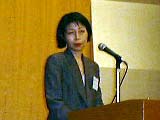![]()
| S-9-4 The possible role of PG-M/versican in human coronary restenosis after angioplasity |
| K. Imanaka-Yoshida and T. Yoshida Department of Pathology, Mie University School of Medicine, Tsu, 514-8507, Japan |

![]()
Migration and proliferation of the vascular smooth muscle cells, and synthesis of extracellular matrix(ECM) proteins by these cells are thought to be involved in percutaneous transluminal coronary angioplasty(PTCA). To clarify the mechanisms of human coronary restenosis, restenotic tissue specimens obtained by directional coronary atherectomy from patients at various stage after PTCA were analyzed for cell proliferation and deposition of all extracellular matrix. The timing of cell proliferation and deposition of extracellular matrix protein were compared with the timing of restenosis detected in angiographical studies. Immunostaining with anti-Ki-67 antigen antibody showed the peak of cell proliferation in neointima occurs earlier than the angiographical restenosis.
To define the nature of the in human restenotic neointima, we morphologically and semiquantificationally analyzed with anti-fibronectin, tenascin-C, collagen I and III, and PG-M/versican antibodies. Tenascin-C transiently appeared at the early stage, then PG-M/versican markedly accumulated when the clinical restenosis most progressed. At later stages, the PG-M/versican was replaced by a more mature ECM consisting of collagen I and III. These results demonstrated that different ECM elements could play distinct roles in a cascade of biological events and the volume effect of accumulation of PG-M/versican can be a major cause of human coronary restenosis after PTCA.
![]()